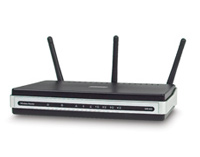Use this chart to get some quick information to help you differentiate between the available wireless networking standards and choose which standard might be the right fit for your business. See the links below the chart for further information on wireless networking standards.
| Standard | Data Rate | Modulation Scheme | Security | Pros/Cons & More Info |
|---|---|---|---|---|
| IEEE 802.11 | Up to 2Mbps in the 2.4GHz band | FHSS or DSSS | WEP & WPA | This specification has been extended into 802.11b. |
| IEEE 802.11a (Wi-Fi) | Up to 54Mbps in the 5GHz band | OFDM | WEP & WPA | Products that adhere to this standard are considered "Wi-Fi Certified." Eight available channels. Less potential for RF interference than 802.11b and 802.11g. Better than 802.11b at supporting multimedia voice, video and large-image applications in densely populated user environments. Relatively shorter range than 802.11b. Not interoperable with 802.11b. |
| IEEE 802.11b (Wi-Fi) | Up to 11Mbps in the 2.4GHz band | DSSS with CCK | WEP & WPA | Products that adhere to this standard are considered "Wi-Fi Certified." Not interoperable with 802.11a. Requires fewer access points than 802.11a for coverage of large areas. Offers high-speed access to data at up to 300 feet from base station. 14 channels available in the 2.4GHz band (only 11 of which can be used in the U.S. due to FCC regulations) with only three non-overlapping channels. |
| IEEE 802.11g (Wi-Fi) | Up to 54Mbps in the 2.4GHz band | OFDM above 20Mbps, DSSS with CCK below 20Mbps | WEP & WPA | Products that adhere to this standard are considered "Wi-Fi Certified." May replace 802.11b. Improved security enhancements over 802.11. Compatible with 802.11b. 14 channels available in the 2.4GHz band (only 11 of which can be used in the U.S. due to FCC regulations) with only three non-overlapping channels. |
| IEEE 802.16 (WiMAX) | Specifies WiMAX in the 10 to 66 GHz range | OFDM | DES3 and AES | Commonly referred to as WiMAX or less commonly as WirelessMAN or the Air Interface Standard, IEEE 802.16 is a specification for fixed broadband wireless metropolitan access networks (MANs) |
| IEEE 802.16a (WiMAX) | Added support for the 2 to 11 GHz range. | OFDM | DES3 and AES | Commonly referred to as WiMAX or less commonly as WirelessMAN or the Air Interface Standard, IEEE 802.16 is a specification for fixed broadband wireless metropolitan access networks (MANs) |
| Bluetooth | Up to 2Mbps in the 2.45GHz band | FHSS | PPTP, SSL or VPN | No native support for IP, so it does not support TCP/IP and wireless LAN applications well. Not originally created to support wireless LANs. Best suited for connecting PDAs, cell phones and PCs in short intervals. |
| HomeRF | Up to 10Mbps in the 2.4GHZ band | FHSS | Independent network IP addresses for each network. Data is sent with a 56-bit encryption algorithm. | Note: HomeRF is no longer being supported by any vendors or working groups. Intended for use in homes, not enterprises. Range is only 150 feet from base station. Relatively inexpensive to set up and maintain. Voice quality is always good because it continuously reserves a chunk of bandwidth for voice services. Responds well to interference because of frequency-hopping modulation. |
| HiperLAN/1 (Europe) | Up to 20Mbps in the 5GHz band | CSMA/CA | Per-session encryption and individual authentication. | Only in Europe. HiperLAN is totally ad-hoc, requiring no configuration and no central controller. Doesn't provide real isochronous services. Relatively expensive to operate and maintain. No guarantee of bandwidth. |
| HiperLAN/2 (Europe) | Up to 54Mbps in the 5GHz band | OFDM | Strong security features with support for individual authentication and per-session encryption keys. | Only in Europe. Designed to carry ATM cells, IP packets, Firewire packets (IEEE 1394) and digital voice (from cellular phones). Better quality of service than HiperLAN/1 and guarantees bandwidth. |
| OpenAir | Pre-802.11 protocol, using Frequency Hopping and 0.8 and 1.6 Mb/s bit rate | CSMA/CA with MAC retransmissions | OpenAir doesn't implement any encryption at the MAC layer, but generates Network ID based on a password (Security ID) | OpenAir is the proprietary protocol from Proxim. All OpenAir products are based on Proxim's module. |
For more information on wireless networking standards, visit the following links:
WIFI PLANET: A source for Wi-Fi- news and technology.
Wireless Networking Reference – Standards: An index of wireless networking resources on the Web from Practically Networked.
Setting Up a Secure Wireless Network : What you need to know to keep your WLAN secure.
What are my choices?
PERFORMANCE
802.11b radios use Direct Sequence Spread Spectrum (DSSS) technology and HomeRF uses Frequency Hopping Spread Spectrum (FHSS). Each method has its strengths and weaknesses (this article has a relatively easy to understand comparison of the two), but the summary is that Wi-Fi runs faster, but doesn’t go as far (especially while going faster), and HomeRF runs slower, but has greater range (and doesn’t slow down as much as range increases). HomeRF is also pretty much unaffected by microwave oven and 2.4GHz cordless phone operation, where 802.11b networks can be slowed when you decide to heat up a burrito and temporarily shut down if you want to talk on your 2.4GHz phone.
Expect the data rate you get when you use any of these products to be significantly lower than the stated maximums. WiFi products’ best actual data transfer rates are in the 3.5 to 4.5Mbps range and HomeRF clocks in at about 800-900kbps.
Note that these standards can co-exist (although some people might disagree with this statement), but they can’t communicate with each other. You need equipment using the same standard in order to successfully build your network!
Wireless manufacturers typically ship their PCI adapters, but you may need (or want) to do it yourself.
Here are some sources for ISA/PCI to PCMCIA adapters:
SCM Micro’s “Swapbox” series
Envoy Data
You can buy the products in kits, usually for networking two computers, and in single computer add-on packages. The kits sometimes bundle in some sort of Internet sharing software. Most of the products are Windows based, but there are alternatives:
Farallon’s SkyLINE 11Mb PC Card has both Windows and MacOS drivers.
Apple has Airport for Macs primarily, but see this page for information on use with Windows.
Note: If you use the MacOS, pay careful attention to the specifications of the products that you’re buying if you need to use the AppleTalk protocol. Assume that the product does not support it unless the product specifically states that it supports the MacOS. You should be able to use the TCP/IP protocol with any 802.11b product, however.
Also try this listing if you’re looking for Linux support for wireless cards.




